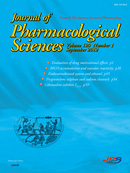Volume 125, Issue 2
Displaying 1-15 of 15 articles from this issue
- |<
- <
- 1
- >
- >|
Current Perspective
-
2014Volume 125Issue 2 Pages 117-124
Published: June 20, 2014
Released on J-STAGE: June 19, 2014
Advance online publication: May 31, 2014Download PDF (326K) -
2014Volume 125Issue 2 Pages 125-131
Published: June 20, 2014
Released on J-STAGE: June 19, 2014
Advance online publication: May 23, 2014Download PDF (309K)
Full Paper
-
2014Volume 125Issue 2 Pages 132-141
Published: June 20, 2014
Released on J-STAGE: June 19, 2014
Advance online publication: May 23, 2014Download PDF (1407K) -
2014Volume 125Issue 2 Pages 142-149
Published: June 20, 2014
Released on J-STAGE: June 19, 2014
Advance online publication: May 16, 2014Download PDF (1347K) -
2014Volume 125Issue 2 Pages 150-156
Published: June 20, 2014
Released on J-STAGE: June 19, 2014
Download PDF (1347K) -
2014Volume 125Issue 2 Pages 157-168
Published: June 20, 2014
Released on J-STAGE: June 19, 2014
Advance online publication: May 20, 2014Download PDF (899K) -
2014Volume 125Issue 2 Pages 169-175
Published: June 20, 2014
Released on J-STAGE: June 19, 2014
Advance online publication: May 23, 2014Download PDF (423K) -
2014Volume 125Issue 2 Pages 176-183
Published: June 20, 2014
Released on J-STAGE: June 19, 2014
Download PDF (875K) -
2014Volume 125Issue 2 Pages 184-192
Published: June 20, 2014
Released on J-STAGE: June 19, 2014
Advance online publication: May 28, 2014Download PDF (1308K) -
2014Volume 125Issue 2 Pages 193-201
Published: June 20, 2014
Released on J-STAGE: June 19, 2014
Download PDF (947K) -
2014Volume 125Issue 2 Pages 202-210
Published: June 20, 2014
Released on J-STAGE: June 19, 2014
Advance online publication: May 30, 2014Download PDF (752K) -
2014Volume 125Issue 2 Pages 211-216
Published: June 20, 2014
Released on J-STAGE: June 19, 2014
Advance online publication: May 30, 2014Download PDF (362K) -
2014Volume 125Issue 2 Pages 217-226
Published: June 20, 2014
Released on J-STAGE: June 19, 2014
Advance online publication: May 30, 2014Download PDF (1163K)
Short Communication
-
2014Volume 125Issue 2 Pages 227-232
Published: June 20, 2014
Released on J-STAGE: June 19, 2014
Advance online publication: May 23, 2014Download PDF (564K) -
2014Volume 125Issue 2 Pages 233-236
Published: June 20, 2014
Released on J-STAGE: June 19, 2014
Advance online publication: May 30, 2014Download PDF (303K)
- |<
- <
- 1
- >
- >|
